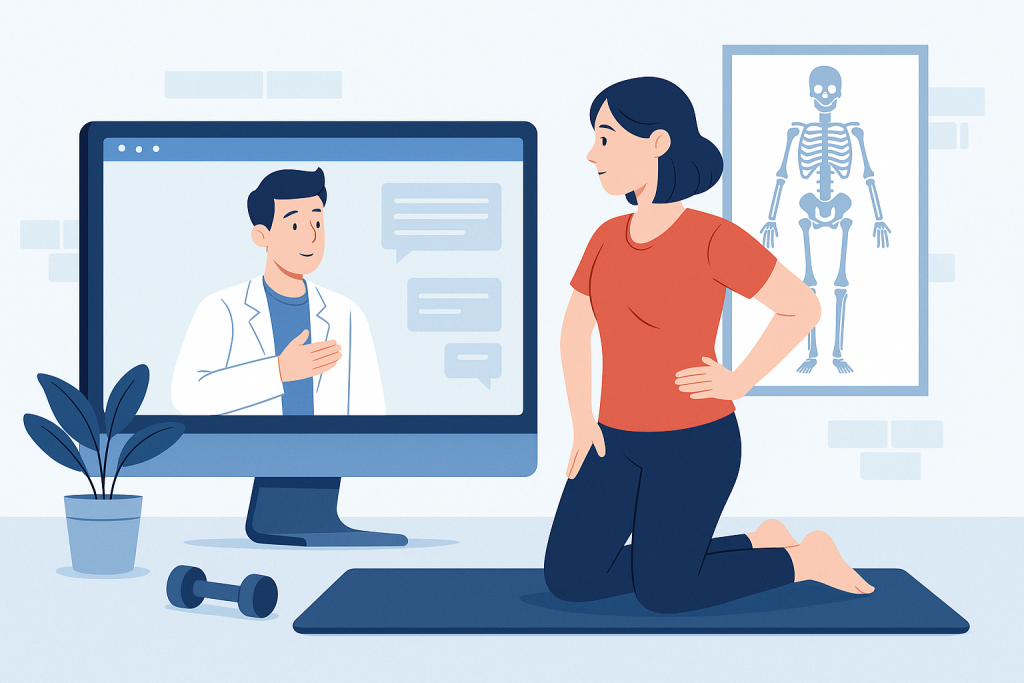Today, almost everything we need is available online—from clothes to school lessons. Now, even health care has gone digital. But what about virtual physiotherapy? Can online physiotherapy really help people recover from pain and injuries?
Let’s find out if virtual physiotherapy actually works, and whether it’s a good choice for you.
What Is Virtual Physiotherapy?
Virtual physiotherapy, also known as online physiotherapy or online rehab, means getting physiotherapy help through a video call instead of going to a clinic. Everything happens online, using your phone, laptop, or tablet.
You meet your physiotherapist face-to-face through a screen. They talk to you, watch how you move, and teach you exercises that can help you recover from pain, stiffness, or injury. Click here to know how!
How Does It Work?
Here’s how virtual physiotherapy works:
- Book an Appointment
You can easily book through a website or phone call. - Join a Video Call
Just like talking to a friend online, you meet your physiotherapist and explain your problem. - Get a Personalized Exercise Plan
Your physiotherapist gives you a step-by-step plan to follow at home, often with video demos. - Regular Follow-Ups
You meet again online to check your progress and make changes to your plan if needed.
Why Choose Online Physiotherapy?
Many people are now choosing online physiotherapy over regular clinic visits. Here’s why:
1. Saves Time and Travel
No more waiting in traffic or rushing across the city. You can do your virtual physiotherapy session from your living room.
2. Fits Into Busy Schedules
For students, athletes, and working people, online rehab makes it easier to stay on track with treatment.
3. Great for Mild Conditions
For posture problems, muscle stiffness, or early-stage joint pain, virtual physiotherapy works really well.
4. Safer for Health Risks
If you are unwell, recovering from an infection, or living far from a clinic, online physiotherapy is a safe option.
Does Virtual Physiotherapy Really Work?
Now comes the main question: Does virtual physiotherapy work?
✅ Yes, It Works Well For:
- Exercise-Based Treatments:
If your condition can be managed with exercises, stretches, and posture advice, virtual physiotherapy is just as effective as clinic visits. - Real-Time Guidance:
Your therapist can show you how to perform exercises and correct you instantly during the video call. - Good for Motivation:
Many people find that regular online check-ins keep them motivated to complete their rehab program.
❌ When It May Not Work:
- Hands-On Treatments Needed:
Some treatments, like immense pain, joint adjustments or deep tissue release, require in-person care. - Complex Injuries:
Complicated injuries or post-surgery care often need physical support from a therapist. - Neurological conditions: Some conditions like stroke and MND require physical assistance in all exercises.
Research Supports It
Studies have found that virtual physiotherapy is highly effective for problems like back pain, knee arthritis, and posture correction. For example, research in The Journal of Physiotherapy showed that online rehab helped people with knee pain recover just as well as those who went to clinics.
What Can Be Treated with Virtual Physiotherapy?
Here are common problems that online physiotherapy can help with:
- Neck and back pain
- Sports injuries like muscle strains
- Posture-related stiffness from sitting too long
- Shoulder issues like frozen shoulder
- Knee pain from running or arthritis
- Mild post-injury strength training
- General flexibility for fitness and sports
How to Make Online Physiotherapy More Effective
Want to get better results from virtual physiotherapy? Follow these tips:
1. Find a Quiet, Open Space
Choose a room at home where you can stretch and move without things getting in your way.
2. Good Internet
Make sure you have good WiFi setup with good internet speed.
3. Good Camera Setup
Make sure your device shows your full body, so the therapist can guide you properly.
4. Wear Comfortable Clothes
Stretchy clothes help you move freely during exercises.
5. Follow Instructions
If you don’t understand an exercise, ask again. Your therapist is there to help.
6. Stay Consistent
Doing the exercises regularly is the key to faster recovery.

Virtual Physiotherapy vs. In-Clinic Sessions
| Feature | Virtual Physiotherapy | In-Clinic Physiotherapy |
|---|---|---|
| Hands-on Treatments | ❌ Not available | ✅ Yes |
| Convenience | ✅ Very high | ❌ Need to travel |
| Mild Injuries | ✅ Works well | ✅ Works well |
| Complex Cases | ❌ Limited | ✅ Recommended |
| Personalized Exercise | ✅ Yes | ✅ Yes |
Conclusion: Should You Try Virtual Physiotherapy?
So, does virtual physiotherapy really work?
Yes! For many common conditions like back pain, stiff shoulders, and posture problems, virtual physiotherapy works wonderfully. It saves you time, fits easily into your routine, and gives you expert guidance at home.
However, if you have a more serious injury or need hands-on treatment, visiting a clinic may be better.
Ready to Get Started?
If you’ve been ignoring that annoying back pain or feeling stiff after long hours at a desk, virtual physiotherapy could be your answer. Book your online session today and take the first step toward feeling better—without even leaving your home.
- Dr. Sukanya Dandekar PT
- Senior Neurophysiotherapist
- Rehab Station, Pune
